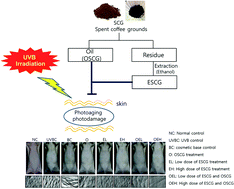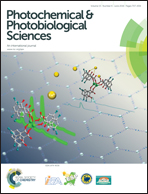Topical application of spent coffee ground extracts protects skin from ultraviolet B-induced photoaging in hairless mice†
Abstract
The aim of this study was to evaluate the protective effect of spent coffee ground (SCG) on ultraviolet (UV) B-induced photoaging in hairless mice. The oil fraction (OSCG) and ethanol extract (ESCG) of SCG were prepared from SCG. OSCG contained a much higher level of caffeine (547.32 ± 1.68 μg mg−1) when compared to the sum of its chlorogenic acid derivatives (∼119 μg mg−1), and pyrazines were the major aromatic compounds in OSCG. OSCG effectively inhibited the UVB-induced increase in intracellular reactive oxygen species in HaCaT cells. Topical application of OSCG or ESCG significantly reduced the UVB-induced wrinkle formation in mice dorsal skin. The combined application of OSCG and ESCG (OEH) led to a decrease in the wrinkle area by over 35% when compared with the UVB-treated control (UVBC). Epidermal thickness was also reduced by 40%. This result was connected to the significant reduction in transdermal water loss (27%) and erythema formation (48%) that result from UVB irradiation. Polarization-sensitive optical coherence tomography (PS-OCT) and antibody-based histological analyses showed that OSCG and ESCG effectively suppressed the UVB-induced decrease in collagen content. The level of type 1 collagen (COL1) in the OEH group was enhanced by around 40% compared with the UVB control group (UVBC). This was attributed to the down-regulation of matrix metalloproteinases (MMP2, 9, and 13), which are known to be responsible for collagen destruction. Our results indicate that topical treatment with OSCG/ESCG protects mouse skin from UVB-induced photoaging by down-regulating MMPs; therefore, suggesting the potential of SCG extracts as a topical anti-photoaging agent.


 Please wait while we load your content...
Please wait while we load your content...